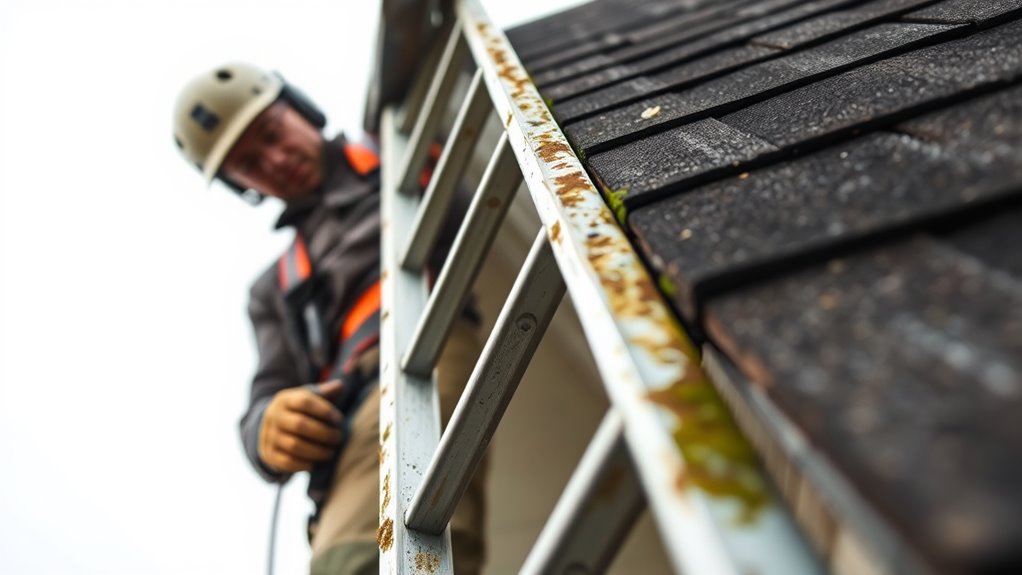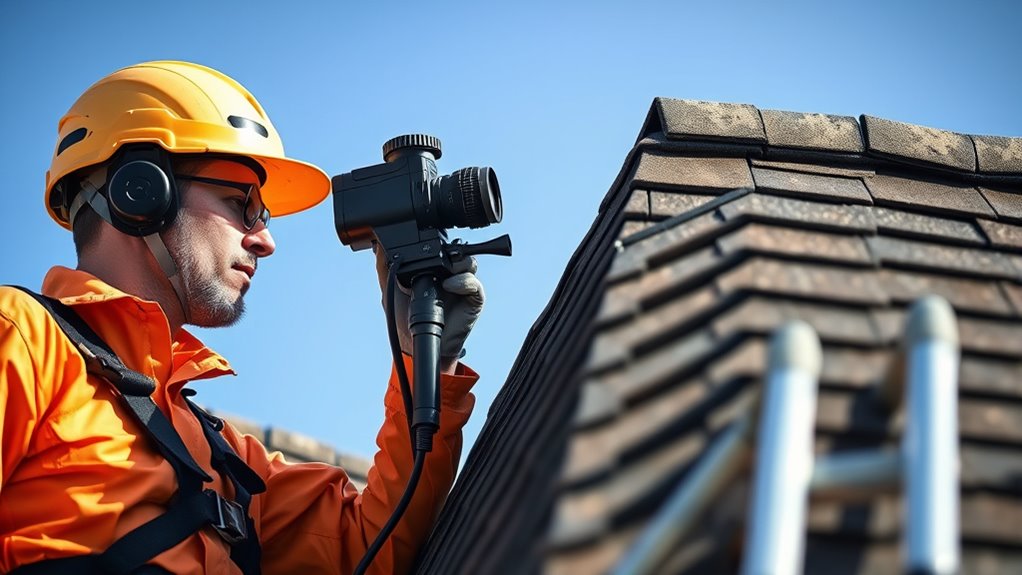To prevent leaks and damage, it’s essential to regularly inspect your roof for missing shingles, damaged flashing, or signs of wear. Keep gutters clean and sealed to guarantee proper water drainage and avoid water infiltration. Schedule professional assessments annually, especially after storms, to spot issues early. Simple maintenance like cleaning debris and repairing small problems can extend your roof’s lifespan. Stay tuned for more tips on protecting your home’s roof.
Key Takeaways
- Schedule regular roof inspections to identify and address minor issues before they lead to leaks or damage.
- Keep gutters clean and sealed to ensure proper water drainage and prevent water infiltration.
- Check for damaged or missing shingles, curling edges, and deteriorated flashing after storms or periodically.
- Remove debris, moss, and leaves from the roof surface to prevent moisture buildup and structural deterioration.
- Consult professional roof assessments for hidden issues and ensure comprehensive maintenance for longevity.

How often do you check your roof? Many homeowners overlook regular inspections, but staying proactive can save you from costly repairs down the line. Regular roof maintenance begins with simple tasks like roof cleaning and gutter sealing. When you keep your roof clean, you remove debris such as leaves, twigs, and moss that can trap moisture. This buildup can lead to rot and deterioration, making your roof vulnerable to leaks. Gutter sealing is equally important because it ensures water flows properly away from your home, preventing water from seeping into your roof or walls. Over time, gutters can develop leaks or become clogged, which can cause water to overflow and damage your fascia or foundation. Regularly inspecting and sealing gutters keeps water where it belongs and reduces the risk of leaks. Additionally, understanding proper maintenance practices can help you extend your roof’s lifespan and prevent costly repairs. Performing routine visual checks can also help you catch minor issues before they become major problems.
You should routinely examine your roof for signs of damage, especially after storms or harsh weather. Look for missing or damaged shingles, curling edges, or any signs of granule loss. These small issues can escalate quickly if left unchecked, leading to leaks and structural damage. During your inspection, also check the flashing around chimneys, vents, and skylights. Damaged or corroded flashing can be a weak point where water sneaks in. Take the time to clear out gutters and downspouts, ensuring they are free of debris. When gutters are clogged, water can back up and seep under the roofing material, causing leaks. Consider investing in gutter sealing if you notice leaks or gaps, as this added layer of protection helps prevent water infiltration. Additionally, understanding best heat pump maintenance practices can help you maintain your home’s overall efficiency and avoid costly HVAC repairs. Performing regular roof inspections is also crucial in early detection of potential issues, saving you money and stress in the long run. Regular professional assessments can identify subtle problems not visible to the untrained eye, further safeguarding your investment.
Frequently Asked Questions
How Often Should I Schedule Professional Roof Inspections?
You should schedule a professional roof inspection at least once a year to maintain an effective inspection schedule. Regular inspections help catch minor issues early, preventing costly repairs later. After severe weather, it’s wise to have an additional check. Your maintenance frequency depends on your roof’s age, material, and local climate. Staying consistent with inspections guarantees your roof stays in good shape, protecting your home from leaks and damage over time.
What Signs Indicate My Roof Needs Immediate Repair?
If you notice shingle deterioration, moss growth, or curling edges, your roof needs immediate repair. These signs indicate potential leaks, structural damage, and compromised protection. Don’t ignore loose or missing shingles, dark streaks, or water stains inside your home. Acting quickly prevents costly repairs, water damage, and safety hazards. Regularly check for these signs, and if you spot any, contact a professional to assess and fix the issues promptly.
Can DIY Roof Inspections Effectively Identify Hidden Damage?
DIY roof inspections can help you spot visible issues like damaged shingles or debris, but they often miss hidden damage. To do this safely, follow DIY safety guidelines, such as using proper inspection tools like binoculars and a sturdy ladder. While you can identify obvious problems, professional inspections are recommended for detecting concealed damage that could lead to leaks or costly repairs later on.
What Materials Are Best for Long-Term Roof Leak Prevention?
When choosing roofing materials for long-term leak prevention, prioritize durability, dependability, and water resistance. Asphalt shingles are affordable and reliable, while metal roofs excel at shedding water and resisting damage. Consider slate or clay tiles for longevity and strength. These roofing materials provide robust leak prevention, protect your home from weathering, and ensure peace of mind, so your roof remains resilient against leaks and damage over the years.
How Does Weather Impact the Frequency of Roof Maintenance?
Weather considerably impacts how often you should inspect your roof. Seasonal storms and temperature fluctuations cause wear and tear, making damage more likely. After harsh weather, you should check for missing shingles or leaks. During extreme cold or heat, materials expand or contract, increasing the risk of cracks. Regular inspections help catch issues early, especially in unpredictable weather, so you can prevent costly repairs down the line.
Conclusion
Regular roof maintenance and inspections are your best defense against leaks and damage. Think of your roof like a shield that protects your home—keeping it in good shape is like giving it a strong, reliable armor. Catching problems early prevents costly repairs down the line, saving you time and money. Stay proactive, check your roof often, and don’t ignore small issues; they’re like cracks in a dam that could lead to big problems if left unchecked.









